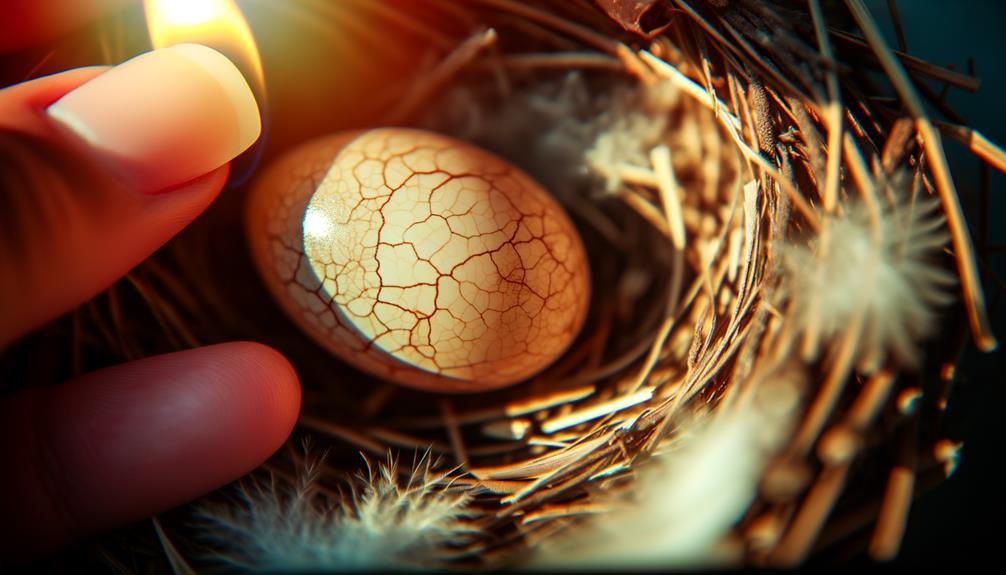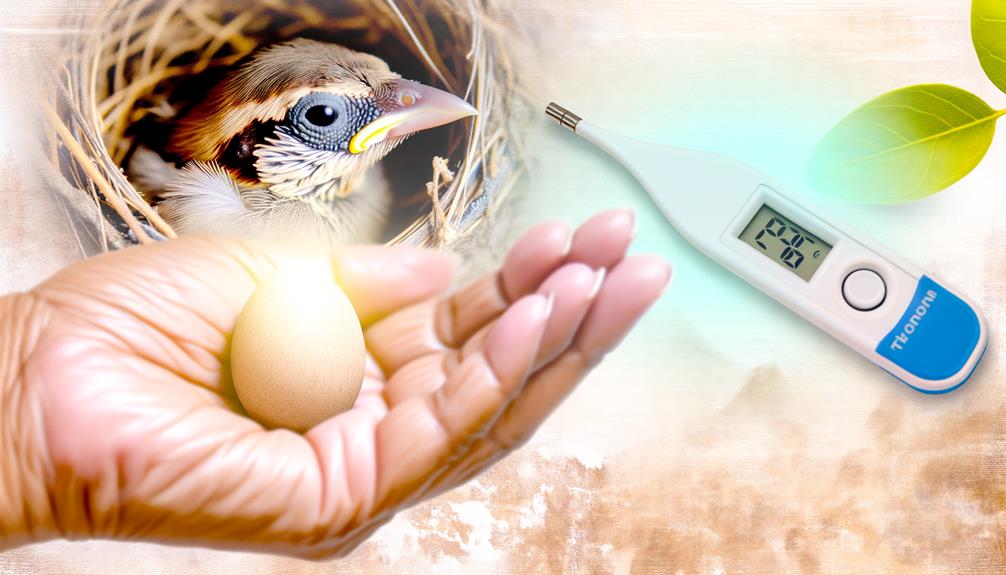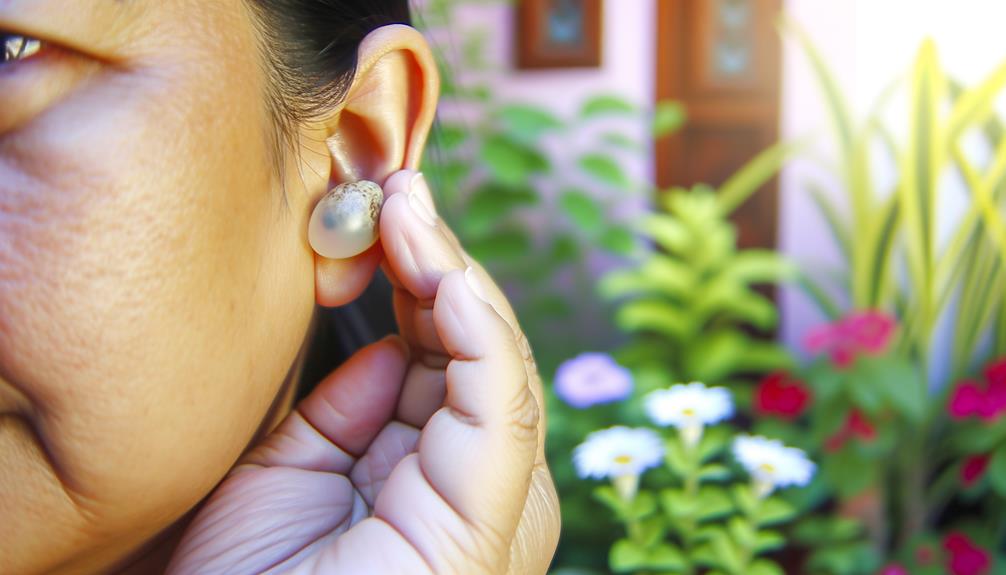Tell if Sparrow Egg Alive in 3 Steps
To determine if a sparrow egg is alive, begin with a visual inspection for cracks, discoloration, or mold. Ensure the shell is smooth and uniformly shaped.
Next, perform candling using a high-intensity LED flashlight to observe embryo movements and blood vessel activity, particularly between days 4 and 7 of incubation. Maintain ideal incubation temperature around 37.5°C (99.5°F) using precise thermometers.
Detect vibrational or movement cues and listen for rhythmic tapping or chirping sounds. Advanced diagnostic techniques like ultrasonography can further confirm viability.
Engage with avian experts for thorough assessment techniques and specialized insights into embryonic health and development.

Key Takeaways
- Use a high-intensity LED flashlight to candle the egg and check for embryo movements and blood vessel activity.
- Maintain consistent temperature around 37.5°C (99.5°F) using precise digital thermometers for accurate incubation.
- Observe for subtle vibrations or shifts in the egg, indicating embryo activity.
- Listen for rhythmic tapping or chirping sounds using an electronic stethoscope.
- Seek expert consultation for advanced diagnostic techniques like ultrasonography and microbiological tests.
Visual Inspection

Upon conducting a visual inspection, one should first examine the shell's integrity, noting any cracks, discolorations, or irregularities that may indicate the egg's viability.
A healthy sparrow egg typically exhibits a smooth, consistent shell texture free from fissures or pitting. Discolorations, such as dark spots or uneven pigmentation, can suggest underlying issues, including bacterial contamination or non-viability. Additionally, the egg should be of uniform shape, typically oval, with no significant deformities.
Carefully scrutinize the shell for any signs of mold or fungal growth, as these can compromise the egg's viability. Ensuring minimal handling, gently rotate the egg to observe its overall structural soundness.
Each of these observations contributes to a preliminary assessment of whether the egg is likely to be viable.
Candling Technique
The candling technique involves using a suitable light source, such as a high-intensity LED flashlight, to illuminate the interior of the egg in a darkened environment. This method allows for detailed observation of the egg's internal structures, helping to identify embryo movement and development.
Suitable Light Source
Utilizing a high-intensity LED flashlight optimizes the candling technique for evaluating the viability of a sparrow egg. The LED flashlight should emit a focused and consistent beam of light to penetrate the eggshell effectively, revealing internal structures without causing thermal stress. Position the egg between the light source and your eye to discern essential features, such as vascular development and air cell size. A reliable LED flashlight ensures precision and minimizes the risk of damaging the egg.
| Light Source | Advantages | Disadvantages |
|---|---|---|
| LED Flashlight | High intensity, low heat | Requires batteries |
| Incandescent | Readily available | Excessive heat, lower clarity |
| Halogen | Bright, clear illumination | Generates significant heat |
| Fluorescent | Low heat, energy-efficient | Bulky, less focused beam |
| Specialized Candling Lamp | Designed for eggs | Expensive, less portable |
Identifying Embryo Movement
Employing the candling technique, one can observe subtle movements within the sparrow egg, indicative of a developing embryo. This process involves holding the egg against a light source, allowing the observer to view the egg's internal structures.
Look for faint, rhythmic movements that suggest the presence of an embryo. These movements are often best seen between days 4 and 7 of incubation. Confirm the light source is sufficiently bright yet not too intense to avoid overheating the egg.
The embryo, if alive, will exhibit slight twitches and blood vessel activity. The presence of these movements confirms embryonic viability and ongoing development, providing critical information for both research and conservation efforts.
Warmth and Temperature

Maintaining the perfect incubation temperature, usually around 37.5°C (99.5°F), is vital for the viability of sparrow eggs.
Continuous monitoring of egg warmth guarantees that the embryo develops under best conditions, preventing any potential harm from temperature fluctuations.
Utilizing precise temperature measurement tools, such as digital thermometers and calibrated incubators, enhances the accuracy of these observations.
Ideal Incubation Temperature
The perfect incubation temperature for sparrow eggs is crucial for embryonic development and should be carefully maintained between 99°F and 101°F (37.2°C to 38.3°C).
This precise thermal range ensures prime conditions for cellular growth and metabolic processes.
To achieve and sustain this temperature, the following guidelines are essential:
- Utilize a dependable incubator: Guarantee it has accurate temperature controls and a stable heat distribution.
- Regularly calibrate instruments: Periodically check thermometers and incubators for precision.
- Monitor ambient conditions: Keep the surrounding environment stable to prevent temperature fluctuations.
- Implement a backup power source: Ensure continuous operation in case of electrical failures.
Maintaining these parameters is essential in fostering the successful hatching of sparrow eggs.
Monitoring Egg Warmth
Careful monitoring of egg warmth is essential to ensuring the viability of sparrow embryos, necessitating the use of precise thermometers and consistent temperature checks.
Maintaining an ideal temperature range, typically between 37.5°C and 38.5°C, is crucial to embryonic development. Deviations from this range can lead to developmental issues or embryo mortality.
Regularly recording temperature data can help identify patterns and anomalies, ensuring timely interventions. It is important to measure the ambient temperature of the incubation environment as well as the temperature directly at the eggshell surface.
Methods such as candling can also help assess internal conditions indirectly by observing embryonic activity. Consistency in these practices aids in creating a stable, nurturing environment for the developing sparrow embryos.
Temperature Measurement Tools
Accurate temperature measurement tools, such as digital thermometers, infrared thermometers, and temperature data loggers, are indispensable in monitoring the warmth and stability of sparrow egg incubation environments. Proper use of these tools guarantees ideal conditions for embryonic development.
- Digital Thermometers: Offer precise readings, crucial for maintaining temperatures between 37°C to 38°C.
- Infrared Thermometers: Enable non-contact temperature measurement, reducing the risk of disturbing the eggs.
- Temperature Data Loggers: Continuously record temperature fluctuations, providing a detailed thermal profile over time.
- Thermocouples: Ideal for embedding in incubator setups, allowing for real-time monitoring and adjustments.
Utilizing these devices, researchers and avian caretakers can systematically ensure that sparrow eggs receive consistent, life-sustaining warmth.
Movement Detection
Observing subtle vibrations or shifts in an egg can provide vital insights into whether a sparrow embryo is active and developing. Employing a methodical approach, one can utilize visual and tactile assessments to detect these movements. Carefully place the egg on a level, steady surface and observe it under a strong light. Minute twitches or gentle rocking movements signify embryonic activity. For enhanced accuracy, consider using a magnifying lens or a specialized egg movement detector. Consistency in observations is essential, as movement may be intermittent.
| Observation Tool | Purpose |
|---|---|
| Strong light | Illuminate egg interior |
| Level, steady surface | Minimize external vibrations |
| Magnifying lens | Detect minute movements |
| Egg movement detector | Measure subtle shifts |
| Consistent observations | Ensure reliable data collection |
Such detailed assessments are vital in determining the viability of the sparrow egg.
Listening for Sounds

Utilizing auditory techniques, one can listen for faint sounds such as tapping or chirping that may indicate the presence of a living sparrow embryo within the egg. This method, while requiring patience and a quiet environment, can yield valuable information.
To effectively employ this technique, follow these steps:
- Select a Quiet Environment: Make sure the surroundings are free from noise to facilitate the detection of subtle sounds.
- Use a Stethoscope: A medical stethoscope can amplify faint noises, making it easier to discern any activity within the egg.
- Gently Position the Egg: Hold the egg carefully to avoid causing any harm, positioning it close to the stethoscope's diaphragm.
- Listen Intently: Concentrate on identifying rhythmic tapping or chirping sounds, indicative of embryonic importance.
Expert Consultation
Seeking guidance from an ornithologist or avian veterinarian can provide specialized insights and professional assessments regarding the viability of a sparrow egg. These experts utilize advanced diagnostic tools such as candling, which involves illuminating the egg with a bright light to observe embryonic development and vascular structures.
Additionally, they may employ ultrasonography to detect movement or heartbeat, offering a non-invasive method to ascertain viability. An avian veterinarian might also conduct microbiological tests to rule out infections that could compromise the egg's integrity.
These detailed observations, coupled with expert knowledge of avian embryology and physiology, enable precise determination of an egg's status. Seeking expert consultation ensures thorough, scientifically-grounded evaluation, increasing the likelihood of accurate and reliable results.
Conclusion
Determining the viability of a sparrow egg involves careful observation and scientific methods. Visual inspection reveals external integrity, while the candling technique illuminates internal structures.
Warmth and temperature assessments guarantee ideal developmental conditions. Movement detection and listening for sounds provide dynamic indications of life.
Expert consultation offers specialized insights. Through juxtaposition of these methods, a thorough evaluation emerges, blending empirical evidence with expert analysis, thereby enabling a detailed and accurate determination of the egg's viability.






